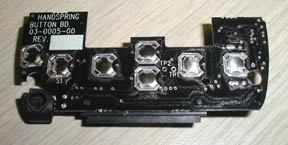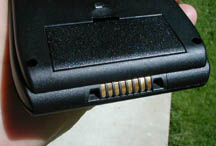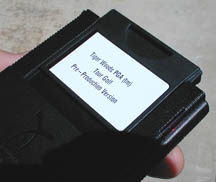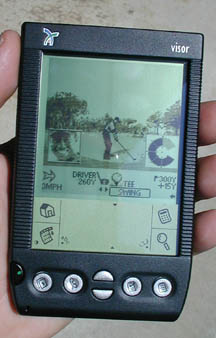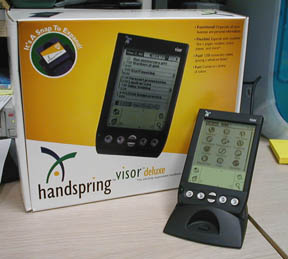 Current Cover
|
|

|
||
Handspring VisorNew handheld from the makers of the original Pilot introduces Springboard expansion slot 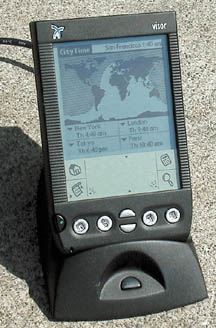
Updated May 1, 2000
On September 14, 1999, the creators of the original Pilot, Jeff Hawkins and Donna Dubinsky,
announced the first product to come from the company they formed in November 1998. The company is Handspring,
and the product is Visor, a Palm-size computer whose basic size, look, and operation are much like the Palm
that came before it. But there's something new lurking in that familiar hardware package, something that
will open up a new world of peripheral expansion for the simple computer that Hawkins envisioned almost
six years ago. It's a new 68-pin socket that will be a jumping off point for the Visor to become so much
more than an organizer, and I suppose that's why they called that socket Springboard.
Lower priced Palm than Palm
The new Visor comes in three models. The Visor, for US$179, gives you a basic platform, with a cradle,
desktop software, and 2MB of RAM. The Visor Solo has no cradle or software for US$149, and is aimed at a
few different kinds of users:
the budget-conscious, enterprises that will use only one cradle to hot sync a number of Visors, as well
as users without computers at all. Finally, the US$249 Visor Deluxe has a cradle and 8MB of RAM, the
maximum addressable by the Motorola Dragonball processor used in all Palm OS machines to date. It also
comes with a leather case and a choice of five colors: graphite (black), blue, green, orange, and ice
(clear). The color and ice versions have a translucent back, with the translucent color appearing only
in the front half of the body's shell. The graphite units are solid black, front and back.
There are a few important enhancements in the Visor software that are not available out of the
box with a Palm, such as an enhanced Date Book, a significantly improved, very versatile calculator,
and a World Clock that is actually a version of City Time, all of which we'll cover later. The main
story is what the new hardware has to offer.
Familiarity
At a glance, any Palm user could pick up a Visor and begin using it like they've owned one for years.
All the buttons are in the same places, as are the Graffiti pad controls. The quick access buttons are
silver, with new, but similar icons representing the four major applications, and the scroll buttons
are once again separated, like the original Pilot. The power button is also in the same place as all
the larger Palms. Slightly different, however, is how the buttons feel when pressed. The feel is more
like a home stereo control panel, with that positive click telling you that the button has been pressed,
instead of the mushy feel of the Palms.
Upon opening the unit up (not recommended for the faint of heart), you can see that the "clicky" feel
is from the use of metal snap domes underneath, instead of the rubber domes used in the Pilot and Palm
III-style units. According to Rob Haitani, Director of Marketing at Handspring, these buttons were used
because they require less travel to actuate, and helped keep the thickness of the Visor the same as the
Palms, despite the considerable tightening of space due to the inclusion of the Springboard slot.
For the Palm III user, getting at the pen of the Visor will be a brief challenge, because they've gone
to a tucked-back version of the original Pilot pen, its flared top accessible on the side again, instead
of at the back. On the old, square Pilot, it stuck out the side, but the visor is tapered abruptly at
the back, just like the Palm III, and the flare is hidden from view. Though the Visor pen looks a little
different, they are cross-compatible with the Pilot pens.
Differences
Just to the lower left of the quick access buttons is a small hole where a microphone is waiting to be
enabled by the first Springboard module that will put it to work. It doesn't interact with the Visor's
onboard hardware, but is wired to two of the 68 pins on the Springboard header where it will be used
by a voice recorder or telephone module when they become available. This will cleverly get around what
many have seen as a shortcoming of the Palm computer, since most Windows CE machines have voice recording built in.
One thing missing from the basic interface that will surely not be missed is the contrast control wheel.
In the lowest left hand corner of the Graffiti screen is a small, half-light, half-dark contrast icon.
Tapping on this icon brings up the contrast slider we've seen on the Palm V. It may be a nuisance at
first when trying to bring down a menu, since the contrast icon shares space with the menu icon, but
general attention to one's taps will soon make this problem a distant memory. The contrast wheel's absence
means case designers will no longer have to worry about working around it in the future.
Just above where the contrast wheel was on the Pilot and Palm III is the IrDA port. It is an odd placement
requiring users to aim their Visors sideways to beam a business card to an associate, but is obviously required
to allow insertion of Springboard slots through the top. Indeed, with the unit apart, it is clear that there
was no other place to put the little send/receive diodes without creating another, separate printed circuit
board just for them. As it is, the internal real estate at the top of the Visor is used up by the Springboard
slot and the LCD.
iMac users especially will be pleased to hear that not only is Mac software shipped on the same CD as
the Windows software, but the Visor's cradle is USB. This offers higher speed HotSyncing, 1.5 megabits
per second versus a maximum of 115 kilobits per second for a Palm connected to a serial port. Those
lacking a USB port can buy the serial port cradle from the Handspring website. The cradle, of course, is not compatible
with old cradles, nor with the Palm modem or its peripherals. At first I thought they were just
being difficult. But then I noticed there appeared to be fewer gold contacts on the bottom of the
Visor: a quick count revealed that there are only eight contacts, compared to a Palm unit's ten. The
port on the Visor itself is indeed a USB port, not the same old serial port made to work with a USB
cradle. Finally I get it. Of course, it would have to be USB through and through to get the speed improvement.
The Visor's case is narrower than a Palm III: it's 3.0 inches wide, compared to the Palm's 3.2 inches.
It's also taller, 4.8 inches compared to 4.7 inches on the Palm. Thickness is the same, but somehow
they managed to lower the weight by a little over half an ounce, with the Visor weighing in at 5.4 ounces
compared to the Palm's 6 ounces. That appears to be a weight measured without the included snap-on cover
and without a Springboard module. Addition of the Tiger Woods module brings it about up to par with the
Palm III, sans flip cover.
As for the snap on cover, it's the one thing on the Visor that could have been done better. It hooks into
two holes left and right of the USB port on the bottom, and snaps into a slot on the top of the Visor. I
suppose I'd use it for protecting the screen of the Visor on a long trip, but I'm sure I'd throw it across
the desk at the office. Unlike the Palm III flip cover, which many have hated as well, the Visor's cover is
at home nowhere unless it's covering the screen. Sure, it's designed to snap on the back of the unit, where
it does indeed cover the HotSync port, and it also keeps any Springboard cartridges from flying out. But what
if you want to change that cartridge, or HotSync? I guess that's when you snap it off and throw it across the
desk. The Palm III cover gets out of your way quickly, and quickly goes back into place to perform its function:
protecting the screen. Not so with the Visor cover. While changing a module, you'll find yourself with two
hands and three objects to hold. Make yourself a nice custom case on the Handspring website and be done with it.
Also of note is that the Visor has no Flash ROM. Palm OS 3.1 is burned permanently in ROM, as it was with the
original Pilot and PalmPilot models. This goes a long way to help lower the price of the Visor. Handspring tells me
they didn't go with Flash ROM because it has been seldom used on the Palm III models. With the Pilots and PalmPilots,
they simply patched the OS when necessary; if the unit was purged, the patch was automatically reapplied by the Palm Desktop.
Still, many will find this undesirable. I don't have a problem with it because the patches have worked quite well,
and most OS upgrades are only for new hardware.
Interface
As for the screen of the Visor, it's the same size as the Palm IIIx, but it appears to be more like the
Palm V. It has blacker pixels and a greener background, instead of the Palm IIIx's yellowish green. To
get those blacker blacks, according to Handspring's Haitani, they increased and tuned the refresh rate just
like they did with the Palm V. The result is a nice, supremely-upgradeable, Palm III-size computer with a
screen nearly as good as the Palm V. As for the backlight, well, let's just say it's nearly as bad as the
backlight on the Palm V. It must be the higher-frequency refresh rate not allowing as much light through
from the backlight. The very same thing that makes the pixels blacker keeps them from lighting up, because
higher refresh means less light transmission, be it reflected or "transmitted" light (all the Palms with
backlights use transflective LCDs, which are both transmissive and reflective). Because they've chosen to
send the light through the pixels instead of around them like they did with the older units, they're always
going to have this problem. Overall, I think the blacker pixels are worth it, but a return to the old
backlight would make for a perfect package.
Boingie, boingie, boingie
Now we come to what makes the Visor an exciting and revolutionary product: the Springboard expansion slot.
Windows CE users have had the luxury of compact flash and PC Card support since the first CE products came
out. Even Newtons, one of the oldest PDAs, had PC Card slots for expansion and backup, but the whole idea
of the Pilot was to make a simple way to carry your basic desktop information and quickly access it on the
go, thus it was called the Connected Organizer; it was never intended to function completely independent
of a desktop or notebook computer. Removable cards and voice recorders would have only made the Pilot more
expensive and more complicated, and that is not what Jeff Hawkins thought was necessary to succeed in the
handheld computer market.
His logic paid off. After all, bells and whistles hadn't worked before. His simple PDA model won a few
customers, then scads of customers, until Microsoft finally took notice. Now there are all sizes of personal
digital assistants, many with a Microsoft logo, but after trying many form factors, the "Palm-size" is
emerging as the most popular of them all. Four years after the launch of the Pilot, the market has changed
considerably, and what did just fine to refocus the then directionless, faltering handheld market will
no longer do. True, the Palm's abilities have already been extended with more memory, memory that allows
one to run more and more programs which further extend its capabilities. IrDA was added to easily transfer
information from Palm to Palm, and many peripherals have been developed to work with its simple serial port.
A whole industry has developed to give the Palm more abilities than Jeff could have ever imagined. The Palm
is no longer the simple organizer it was, it has evolved.
Now millions of Palm users have seen what a PDA can do for them, and many want more: voice recorders,
MP3 players, wireless internet, pagers, games, external storage, GPS receivers, digital cameras, cell
phones--they want it all, and they want it all to work with their PDA. The Visor with its Springboard
expansion slot aims to give them that.
The Springboard expansion slot offers much more than external storage. While there is a backup module
and an 8MB Flash module available at product launch, the Springboard slot has been designed to accommodate
a battery on the module when necessary, and unlike a PC or CF card, it can grow bigger than the size
of the slot, protruding either out the back or over the top of the Visor unit, making room for cellular
phone modules, pager modules, data acquisition units--whatever can be envisioned and built--all with
their own buttons, jacks, lights, speakers, and ports. The Visor needn't been cracked open to upgrade;
upgrade is as easy as inserting a Gameboy-like cartridge. Springboard makes things a little easier for
third party manufacturers, and a lot easier for users.
To make things even easier for the user, the Springboard specification calls for complete plug-and-play
hot-swapability. The sample EA Sports Tiger Woods PGA golf program that came with our review unit can
be plugged in with the unit on or off, and unplugged mid-swing if so desired without a crash or burp.
Plug the module back in and the program comes right up, whether the unit is on or off, and it asks if
you want to start a new game or resume the old one. Click on any of the Visor control buttons or Graffiti
screen areas, and you leave Mr. Woods behind and go to the Palm OS. Want to go play some more Golf?
Click on applications, and you'll see the Tiger icon, with a square dot before the name, and a click
takes you back to the Links with your old buddy Tiger. Yank the module out, and that icon disappears
from the Applications screen and you have a clean Visor, ready for what's next. Pretty cool. No floppies.
No CDs. No drivers. No cradles. No other computers at all. The modules just work, loading and unloading
when they are inserted or removed. (When a Flash Module is being written to, however, the module should not be removed.)
To enable faster and easier acceptance of Springboard, it was designed using the same 68 pin header of
the PC Card (though the pinout is different). This will make it easier for designers to build cards that are compatible with Springboard,
and enable them to use the same, readily-available sockets that have become an industry standard. To
encourage the spread of the Springboard's open standard, Handspring asks no fees or royalties of third
party Springboard developers. All specs for developing springboard modules can be downloaded freely from
the Handspring website. It is hoped that the same openness that fostered such a huge family of software
developers will help get Springboard accepted and continue to expand the Palm dynasty.
Speed
There are many speed improvements in the Visor that are worth mentioning. Peripherals connected through
the Springboard port have a speed advantage over peripherals connected through the Palm serial port. Because
the connection gives the Springboard module direct access to the processor, speed goes from the 57.6K maximum
through the serial port to around 290 times that speed through the Springboard connection, according to
Haitani. Also, though there are currently no plans to build devices that connect through the Visor's USB
port, communications here are said to be 70 times faster than the Palm serial port. The only thing slated
to use this port besides the cradle is the Stowaway keyboard from Think Outside, currently still in
development (this is a very nice full size keyboard that folds down to a size only a little larger than
the Visor itself).
The final speed improvement is shown in the CPU performance. While it uses the same CPU as the IIIx
and Palm V, and runs at the same clock speed, some of the engineers at Handspring noticed some wait
states that were unnecessarily high and adjusted them accordingly, according to Haitani. The result
is that the Visor performs 58 percent faster than the Palm IIIx, according to the Neil Bridges Benchmark program.
Software
Getting back to the new software features, the new Date Book Plus appears to be based on Datebk3 by Pimlico
Software. Hats off to Handspring for recognizing a good thing and getting it for their product. It offers
five views of your calendar, instead of three, including a weekly view and annual view. The To Do list is
now integrated as well, so you can create unscheduled events that float along from day to day until you complete
them. Somewhat annoyingly, the old Date Book remains in your Applications list, and there doesn't appear to
be anything that can be done about it, because they both reside in flash RAM, but you can change your quick
launch button to go to Date Book Plus by default.
The calculator gets a long-needed enhancement, making it so much more useful than before that I'm sure I'll
use it all the time. It has nine modes, including Math, Trig, Finance, Logic, Statistics, Weight/Tmp, Length,
Area, and Volume. For various conversions alone it could change my life again. Conversions of any kind usually
send me running the other way, but when it's important, I go to my little black reference book which then
overwhelms me with its 50-some conversions for a cubit. Now I just enter the number into the Visor Calculator,
say 1.4 acres, press on the acre button, then press the conversion button I want, say square meters, and I
get the number: 5,665.589. Sheesh. I can do this.
City Time is the last program that comes bundled with the Visor, and what a great program it is. This is a slightly
older version than what is available for $17.95 from Code City software, but it is a great program. Read my review
in the June issue or on the website for complete coverage. To summarize, it's a world clock that displays five times
for user-selectable cities around the world, and displays a geochron view of the world, complete with a day/night view,
showing where the sun is shining at any given moment in the day.
Potentials and pitfalls
It is clear that the Springboard expansion slot gives peripheral designers just the gateway they've been looking
for into the Palm OS marketplace. There are a number of developers with products already on the drawing board for
release this year and next year; among them are pagers, reference modules from Concept Kitchen, Franklin Covey, and
Merriam-Webster, games, the Handspring modem, sensor modules, an MP3 encoder and decoder module, voice recorder
modules, map modules, a GPS module, an OmniRemote module, a RioPort digital audio player module, and even a Bluetooth
communications module slated for Fall 2000. Add all the Palm software already on the market, and the Visor will be
able to do a great many things.
One of the obvious problems, however, will be when you want to do more than one thing at a time with your Visor.
Suppose you want to play Tiger Woods, but you don't want to miss a page. The pager will need to be designed to work
while unplugged if it's still going to be truly useful to the person who wants the full functionality of his Visor.
Another potential problem comes in if more than a few companies decide to release software in cartridge form only.
Naturally, it would be an advantage to game companies to use this as a method of copy protection. That would be okay,
except for the inevitable cartridge clutter, but suppose major application developers decided to lock their programs
up in a module: you'd have to swap modules just to perform simple tasks. That could get frustrating.
Techno nuts like myself are sure to want to have a GPS module running, plus a cell phone with an integrated pager on
while I drive down the road listening to my MP3 player module. I guess guys like me are going to have to buy a couple
of the low-priced US$149 Visor Solo units to run all those things, while our 8MB unit stores the novels, addresses, and
the last year's worth of email. The single slot might end up being a pain, but I think it might also help sell more
Visors as our needs expand. It could be a better marketing plan than I thought, making the Visor a common base computer
to address any number of necessary tasks with a familiar interface. Rather than bundle the OS with every type of
device as in Microsoft's plan--tweaking it a bit depending on the hardware--make every device compatible with a
single computer, removing the need to reinvent the computer wheel with every application, thus lowering the price
of each device. Making peripherals conform to a single platform has worked with the PC, why not the Visor?
Which reminds me of the last question I had for Handspring: Why Visor? What does that name mean, anyway? Turns out
it would better be written 'visor, as in advisor. Works for me. Makes about as much sense as Pilot, so why not? (A reader also
pointed out that in many languages, "visor" translates as viewscreen or monitor.)
Now at a store near you...
As of mid-April, 2000, you can get the Visor at your local Best Buy, CompUSA, and Staples. The Visor will still be available
on their website.
Also available for order are their first
three peripherals: the Quick Backup module (US$39.95), capable of taking the place of a desktop computer
for backing up your valuable data; the 8MB Flash Module (US$99.95), intended for developers and power users;
and the EA Sports Tiger Woods PGA Tour Golf module. The modem module is also shipping, as are a number of other modules.
Also available on the site is the ability to design your own custom carrying case, "using a
simple online process to choose from a variety of styles, colors, and materials, and customers can even have
their initials imprinted on their case." Sounds like fun.
| ||||
|
[Homepage] All contents ©1995-2000 Pen Computing Magazine, Inc. All rights reserved. |
||||

